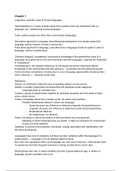Summary
Midterm summary Sociolinguistics
- Course
- Institution
- Book
Clear explanations and summary of chapters 1-6, all you have to know for the sociolinguistics midterm. Everything the book covers, supplemented with own explanations and coherent structures.
[Show more]




